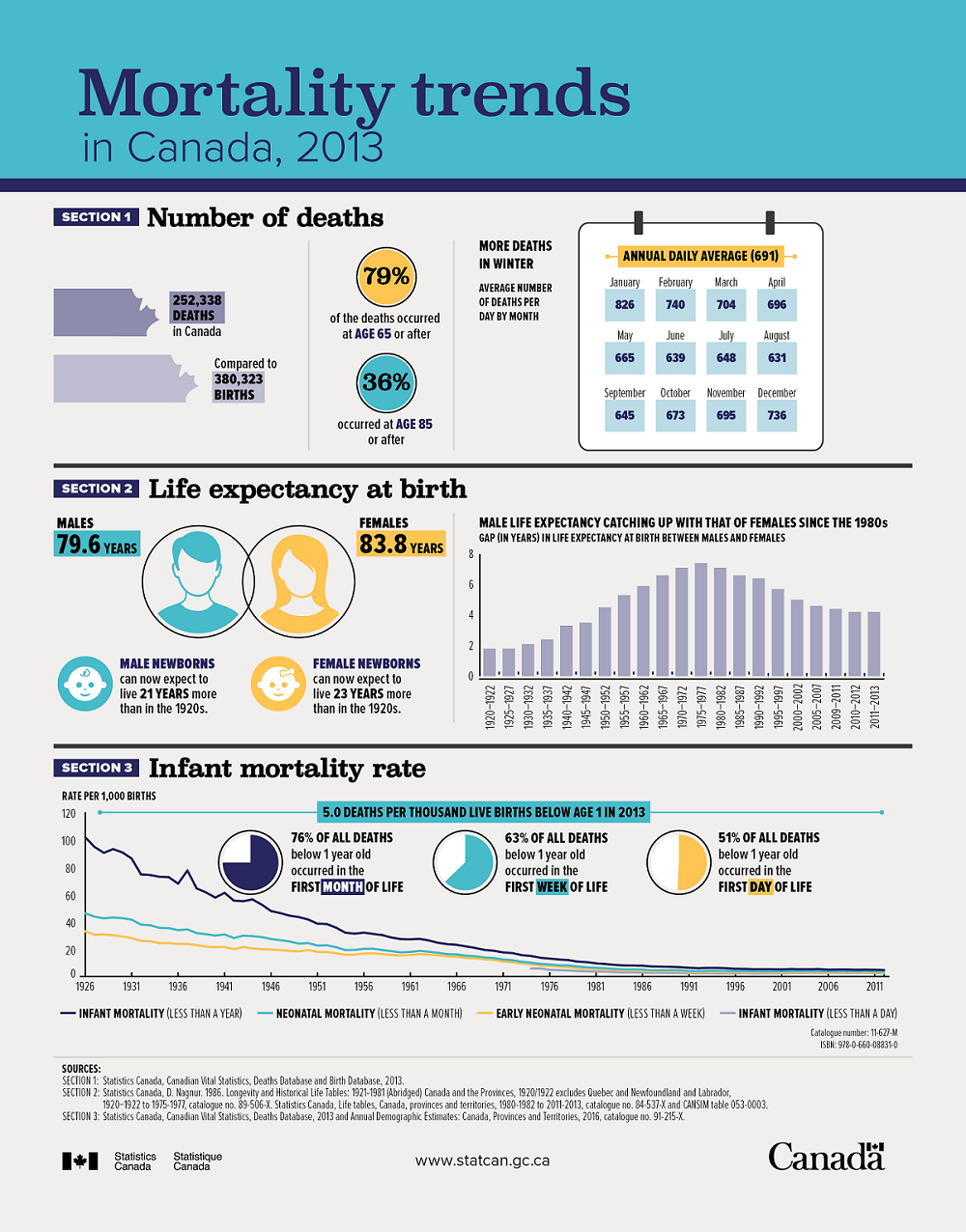Mortality: Overview, 2012 and 2013
Archived Content
Information identified as archived is provided for reference, research or recordkeeping purposes. It is not subject to the Government of Canada Web Standards and has not been altered or updated since it was archived. Please "contact us" to request a format other than those available.
Released: 2017-07-12
The life expectancy of men is slowly catching up to that of women
From 2010/2012 to 2011/2013, life expectancy at birth increased by 2.4 months for men to 79.6 years, and 1.6 months for women to 83.8 years.
Since the early 1980s, the life expectancy of men has increased more rapidly than that of women. Over the past 10 years, the average annual life expectancy gains were 3.0 months for men and 2.2 months for women.
As a result, the gap between life expectancy for men and women was only 4.2 years for the period 2011/2013, while it was more than 7 years in the late 1970s. The main reason for this change is the reduction in the mortality differentials associated with cardiovascular diseases between men and women (section 2 of infographic 1).

In celebration of the country's 150th birthday, Statistics Canada is presenting snapshots from our rich statistical history.
In Canada, life expectancy at birth has almost doubled since Confederation. At the time of the first Canadian census in 1871, life expectancy at birth was 43.7 years for women and 41.4 years for men. According to the latest life tables, based on the period 2011/2013, life expectancy at birth has reached 83.8 years for women and 79.6 years for men.
This notable increase in life expectancy at birth is attributable to several factors, including improved nutrition and sanitation (including access to safe drinking water), advances in medicine and pharmacology (including immunization, improved technologies and knowledge, including maternal health), and improved access to health care and services.
Life expectancy in Canada is among the highest in OECD countries
According to data compiled for about 40 Organisation for Economic Co-operation and Development (OECD) countries, Canada ranks 13th among women (83.8 years) and 11th among men (79.6 years) in terms of life expectancy at birth.
Among women, Japan had the highest life expectancy at birth in 2013 (86.6 years), followed by Spain (86.1 years), France (85.6 years) and Italy (85.2 years). Among men, the highest life expectancy at birth was observed in Switzerland (80.7 years) in 2013, followed by Iceland (80.5 years), Italy (80.3 years), Israel (80.3 years) and Japan (80.2 years).
Life expectancy at birth in the United States, compared to Canada, was 2.6 years lower for women (81.2 years) and 3.2 years lower for men (76.4 years).
Life expectancy gains occur mostly after the age of 65
Today, gains in life expectancy at birth occur mostly after the age of 65, whereas in the early 20th century these gains were mainly due to decreases in infant (under 1 year) and juvenile (between 1 year and 4 years) mortality.
For the period 2011/2013, life expectancy at age 65 reached 18.9 years for men and 21.9 years for women. In comparison, life expectancy at age 65 was almost half as high in 1871, at 10.6 years for men and 11.5 years for women.
Moreover, about one-third of newborns born in 1871 could expect to reach 65 years of age, compared with 9 in 10 for newborns born in the period 2011/2013.
Sharp decrease of infant mortality since 1871
The infant mortality rate, for children under 1 year of age, has decreased sharply since 1871. For example, a child born in Canada during the period 2011/2013 was 30 times more likely to celebrate their first birthday than a child born in 1871.
At the time, infant mortality was 175.5 per 1,000 live births for boys and 153.4 per 1,000 live births for girls. For the period 2011/2013, these rates were 5.2 and 4.5 deaths per 1,000 live births, respectively. These rates have remained relatively stable over the last 10 years (Section 3 of infographic 1).
In 2013, almost two-thirds (63%) of deaths for children under 1 year of age occurred in the first week of life, and just over three out of four (76%) during the first month of life.
More deaths in winter than in summer
Since the mid-1930s, the number of deaths registered in Canada for the population as a whole has been on an upward trend, reaching 252,338 in 2013.
The increase in the number of deaths can be explained by two factors: population growth, since a larger population leads to an increase in the number of deaths; and an ageing population, since the population has proportionally more people at advanced ages with a higher mortality rate.
In 2013, there was an average of 21,028 deaths per month in Canada, or 691 deaths per day (section 1 of infographic 1). The highest daily death rate was recorded in January (826 deaths per day), followed by February (740 deaths).
In the months of November, December, January, February, March and April, the daily number of deaths was above average. The lowest average daily number of deaths was in August (631 deaths per day) and in June (639 deaths). The daily average number of deaths per month takes into account the number of days per month and leap years.
The winter/summer death ratio for Canada was 1.16 in 2013, which means the number of deaths in winter was 16% higher than the number of deaths in summer. From 1974 to 2013, this ratio averaged 1.11, ranging from 1.02 in 1979 to 1.24 in 1998.
Life expectancy is highest in British Columbia
British Columbia had the highest life expectancy at birth in the country in 2011/2013, for men (80.4 years) and for women (84.4 years). This situation has remained unchanged since 1994/1996 for women and since 1980/1982 for men. Among the provinces, life expectancy was lowest in Newfoundland and Labrador, where it was 77.4 years for men and 81.6 years for women.
Of all the provinces and territories, Nunavut had the lowest life expectancy in 2011/2013, at 68.4 years for men and 72.9 years for women. A significant proportion of the population in Nunavut declares an Aboriginal identity, mostly Inuit. Life expectancy at birth in Nunavut was below the national average, with a difference of 11.2 years for men and 10.9 years for women. These differences are due in particular to different living conditions, for example, due to the climate.
Note to readers
This release summarizes a more detailed article that analyzes historical trends in deaths and mortality in Canada, overall and across provinces and territories, with an historical perspective.
How to interpret life expectancy
Life expectancy at birth is the average number of years that newborns would live if they experienced during their lifetime the age-specific mortality rates observed during the period 2011 to 2013.
The life tables published with this article also provide information on life expectancy at other ages, according to the mortality rates observed during a given period (2011/2013).
The life expectancy at birth of Canadians born during the 2011/2013 period will very likely be higher than the life expectancy at birth shown in this article, because they will experience reductions in mortality rates throughout their lives.
Reference period
Data on deaths over a three-year period, taken from Canada's Vital Statistics (3233), are used to calculate the life tables. The most recent tables cover the 2011/2013 reference period and are based on deaths that occurred in 2011, 2012 and 2013.
Products
A more detailed analysis can be found in the article "Mortality: Overview, 2012 and 2013," available in the publication Report on the demographic situation in Canada (91-209-X).
The publication, Life Tables, Canada, Provinces and Territories (84-537-X), includes complete life tables (for Canada, Newfoundland and Labrador, Nova Scotia, New Brunswick, Quebec, Ontario, Manitoba, Saskatchewan, Alberta and British Columbia) and abridged life tables (for Prince Edward Island, Yukon, the Northwest Territories and Nunavut) for 2011/2013.
The tables for the periods 2005/2007, 2006/2008, 2007/2009, 2008/2010, 2009/2011 and 2010/2012 have been updated on the basis of the most recent population estimates for these periods and a slightly revised methodology. New tables for the period 1980/1982 to 2004/2006 are also available and are based on the same methodology.
All of these tables are available for men, women and both sexes combined, in two formats: CANSIM tables, and annual or historical Excel files.
The methodology on which the complete and abridged life tables produced by Statistics Canada are based has also been updated and is available in the document Methods for Constructing Life tables for Canada, Provinces and Territories (84-538-X).
The infographic "Mortality trends in Canada, 2013," which is part of Statistics Canada – Infographics (11-627-M), is also available.
Contact information
For more information, or to enquire about the concepts, methods or data quality of this release, contact us (toll-free 1-800-263-1136; 514-283-8300; STATCAN.infostats-infostats.STATCAN@canada.ca) or Media Relations (613-951-4636; STATCAN.mediahotline-ligneinfomedias.STATCAN@canada.ca).
- Date modified:




